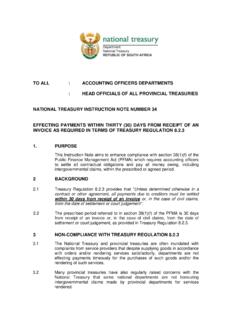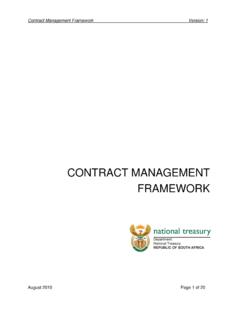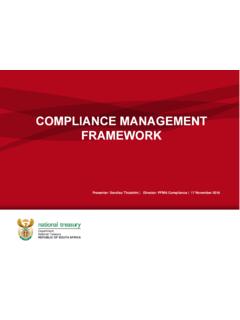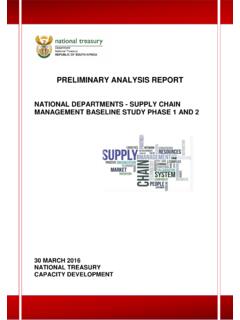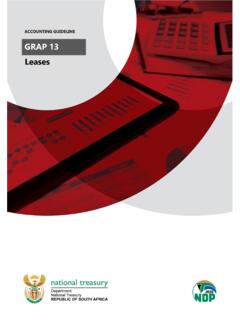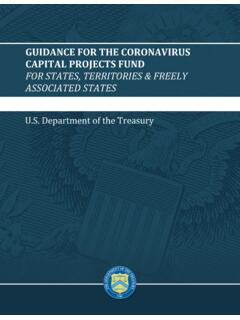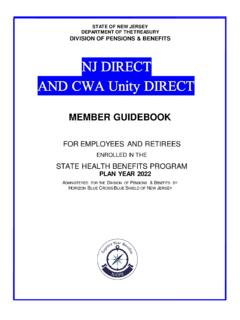Transcription of GRAP 1 - National Treasury
1 1. 2. GRAP 1 Presentation of Financial Statements Effective 1 April 2020. OVERALL CONSIDERATIONS COMPONENTS OF FINANCIAL STATEMENTS. Fair presentation and Going concern Accrual basis of accounting Materiality and Offsetting A complete set of financial statements comprises: compliance with GRAP Financial statements are Entities are required to use aggregation Offsetting of assets and Statement of financial position Financial statements are required to be prepared on accrual basis of accounting Each material class of liabilities or revenue and Statement of financial performance required to be presented a going concern basis except for cash flow similar assets and items of expenses are not permitted Statement of changes in net assets fairly the financial position, (unless entity is in information. dissimilar nature or unless required by other Cash flow statement financial performance and liquidation or has ceased function is to be presented GRAPs. Comparison of budget to actual amounts either as cash flows of an entity.)
2 Operating or there is an Presentation consistency separately. a separate additional statement or as a budget Financial statements indication that the entity An entity is required to column in the financial statements complying with Standards is not a going concern). retain presentation and Comparative information Notes, including of significant accounting policies of GRAP is presumed to classification from one At least 1 year of All statements are required to be presented with result in fair presentation period to the next. comparative information equal prominence. STRUCTURE AND CONTENT. Information required to be presented on the face of the STATEMENT OF FINANCIAL POSITION STATEMENT OF FINANCIAL PERFORMANCE. statements and further information required to be presented in the notes is detailed in GRAP 1 and GRAP 2. Present current and non-current items separately; or All items of revenue and expense recognised in the period Present items in order of liquidity. are included in surplus or deficit unless a Standard of GRAP NOTES TO THE FINANCIAL STATEMENTS.
3 Requires or permits otherwise. Entities must choose Current assets Current liabilities between function of expense method' and nature of Statement of compliance with GRAP along with significant accounting policies, Expected to be realised Expected to be settled in expense method' to present expense items estimates, assumptions, and judgements and additional information useful to in, or is intended for sale the entity's normal users' understanding / decision making or consumption in the operating cycle STATEMENT OF CHANGES IN NET ASSETS. entity's normal operating Held primarily for trading cycle Due to be settled within Represents the total surplus or deficit for the period, other REPORTING PERIOD IDENTIFICATION OF FINANCIAL STATEMENTS. Held primarily for trading 12 months revenues and expenses recognised directly as changes in Must be clearly identified and distinguished from other Financials Expected to be realised The entity does not have net assets, with contributions by and distributions to information in the same published document, and must presented at least within 12 months the right at the end of the owners annually, if longer identify the name of the reporting entity, whether the Cash or cash equivalents.
4 Reporting period to defer financial statements cover the individual entity or the or shorter, entity All other assets are settlement of the liability CASH FLOW STATEMENT. must disclose that economic entity. The reporting date, presentation required to be classified as for at least 12 months. currency, rounding used fact. non-current. Provides users with a basis to assess the ability of the entity All other assets / liabilities to generate cash and need to utilise cash flows are non-current 3. GRAP 2 Cash Flow Statements Effective 1 April 2020. COMPONENTS OF A CASH FLOW STATEMENT. Operating Activities Investing Activities Financing Activities These are the principal activities of the entity and include These relate to the acquisition and disposal of long-term These relate to the activities that cause changes to the activities that are not investing or financing activities. assets and other investments that are not considered to size and composition to the contributed capital and be cash equivalents.
5 Borrowings of the entity. Interests and dividends received/paid may be classified as operating, investing or financing, based on its nature and as long as they are consistently treated from period to period. REPORTING CASH FLOWS FROM OPERATING ACTIVITIES DEFINITION: CASH AND CASH EQUIVALENTS. Cash flows from operating activities must be reported using the Cash and cash equivalents are: direct method. Short-term (where the original maturity is 3 months or less, irrespective of maturity timing post reporting date). Highly liquid investments Readily convertible to known amounts of cash DIRECT METHOD Subject to insignificant risk of change in value Major classes of gross cash receipts and gross payments are disclosed: CONSIDERATIONS TO NOTE. Taxation received Non-cash investing and financing activities must be disclosed separately elsewhere in the financial statements Sale of goods and services Cash flow must be reported GROSS, set-off is permitted in very limited cases Grants Cash flow arising from taxes on surplus will be separately disclosed and will be classified as cash flows from operating activities unless, they Cash paid to employees can be specifically identified Interest received (where appropriate).
6 Cash flows arising from acquisition and disposal of controlled entities or other operating units are investment activities Taxes paid Where the equity method is used for joint ventures and associates, the cash flow statement should only show cash flows between the Net cash from operating activities investor and investee A reconciliation of net cash from operating activities with the Where a joint venture is proportionately consolidated, the entity should only include its proportionate share of the cash flows of the joint surplus or deficit on the statement of financial performance venture Disclose cash not available for use by the entity Foreign exchange transactions should be recorded at the rate at the date of the cash flow Assets and liabilities denominated in a foreign currency generally include an element of unrealised exchange difference at the reporting date Disclose components of cash equivalents and reconciliation to the statement of financial position amount GRAP 3 Accounting Policies, Changes in Accounting 4.
7 Estimates and Errors Effective 1 April 2020. ACCOUNTING POLICIES CHANGES IN ACCOUNTING ESTIMATES ERRORS. DEFINITION DEFINITION DEFINITION. Accounting policies are specific principles, bases, conventions, rules and practices A change in an accounting estimate is an adjustment of the Prior period errors are omissions from and misstatements applied by an entity in preparing and presenting financial statements. carrying amount of an asset or liability, or the amount of in, an entity's financial statements for one or more prior periodic consumption, resulting from assessing the present periods arising from failure to use/misuse of reliable status of, and the expected future benefits and obligations information that: Selection and application of accounting policies: Only change a policy if: associated with, the asset or liability. was available when the financial statements for that If a Standard of GRAP deals with a transaction, Standard of GRAP requires it period are authorised for issue; and use the standard The change will provide could have been reasonably expected to have been Principle: If no Standard of GRAP on a transaction, more relevant and reliable obtained and taken into account in the preparation and Recognise the change prospectively in surplus or deficit in: management judgment should be applied in information presentation of the financial statements.
8 Period of change, if the change only affects that period;. developing and applying an accounting policy Errors include: or resulting in information that is relevant, Principle: Mathematical mistakes Period of change and future periods (if the change reliable and complete in all material respects Apply changes in accounting Mistakes in applying accounting policies affects both). policies: Oversights and misinterpretation of facts The following sources should be referred to, to If change is due to a new Fraud make judgment: Standard of GRAP apply Requirements in other Standards of GRAP (or transitional provisions; Principle: interpretation) dealing with similar issues If no transitional provisions Correct all errors retrospectively. Restate the comparative Definitions, recognition criteria and apply retrospectively amounts for prior periods in which error occurred OR if the measurement concepts in the Framework error occurred before that date, restate opening balance of Use of the most recent pronouncements of assets, liabilities and net assets for the earliest period If impractical to determine other standard setting bodies and accepted presented period specific effects or public or private sector practices to the extent cumulative effects of the that these are not in conflict with the sources change in policy, then above prospectively apply to earliest If impractical to determine If impractical to determine period that is practical cumulative effects o the error, Consistency of accounting policies accounting period specific effects of error, polices should be consistent for similar restate opening balances for restate comparative information transactions.
9 Events or conditions unless required earliest period practicable for the earlies period practicable or permitted otherwise by a Standard of GRAP. 5. GRAP 4 The Effects of Changes in Foreign Exchange Rates Effective 1 April 2020. Monetary items Closing rate at reporting date Gain or loss recognised in surplus or deficit in the period in which it arises DEFINITION INITIAL RECOGNTION SUBSEQUENT RECOGNTION. An entity's functional currency is the currency Spot rate at transaction date Non-monetary items of the primary economic environment which it Rate at transaction date (if item at historical cost). operates Rate at revaluation date (if item carried at fair value). FOREIGN CURRENCY TRANSACTIONS Gains or losses on asset/liability recognised in surplus and deficit START HERE . FUNCTIONAL CURRENCY Principle: When determining the appropriate functional Clear answer ESTABLISHED Exchange gain or loss to surplus and deficit, except where gain currency, the following factors are considered: or loss on non-monetary item recognised in net assets, then Currency influencing revenue such as taxes, translation gain or loss recognised in net assets grants and fines Currency of country whose competitive Consider: Level of authority Translation method: non- forces and regulations determined sale monetary hyperinflationary: prices from reporting entity Loan forming part of net investment in controlled If not autonomous, Assets and liabilities closing Currency mainly influencing input costs for entity: functional currency is rate providing goods or services Exchange gains and losses to separate component of net the same as the Revenue and expenses rate at assets reporting entity transaction date Foreign operation of entity.
10 Recognised in surplus and deficit on disposal of net No clear answer exchange differences shown as investment a separate component of net assets Consider currency in which funds/receipts: From financing activities are generated No clear answer From operating activities are retained Translation method: hyperinflationary: Foreign operation: Assets and liabilities, revenue and Acquisition goodwill and fair value adjustments closing rate expenses closing rate Functional currency hyperinflationary Disposal cumulative exchange differences deferred in net refer to GRAP 10 assets transferred in surplus and deficit 6. GRAP 5 Borrowing Costs Effective 1 April 2020. DEFINITION DEFINITION. Borrowing costs are interest and other expenses incurred by an entity in connection with the borrowing A qualifying asset is an asset that necessarily take a substantial period of time to get ready for its intended of funds use or sale Borrowing costs may include: Examples include: Interest on bank overdrafts and short-term and long-term borrowings Office buildings Amortisation of discounts or premiums relating to borrowings Infrastructure assets, such as roads, bridges and power generation facilities Amortisation of ancillary costs incurred in connection with the arrangement of borrowings Investment properties measured at cost Finance charges in respect of finance leases (in accordance with GRAP 13).
